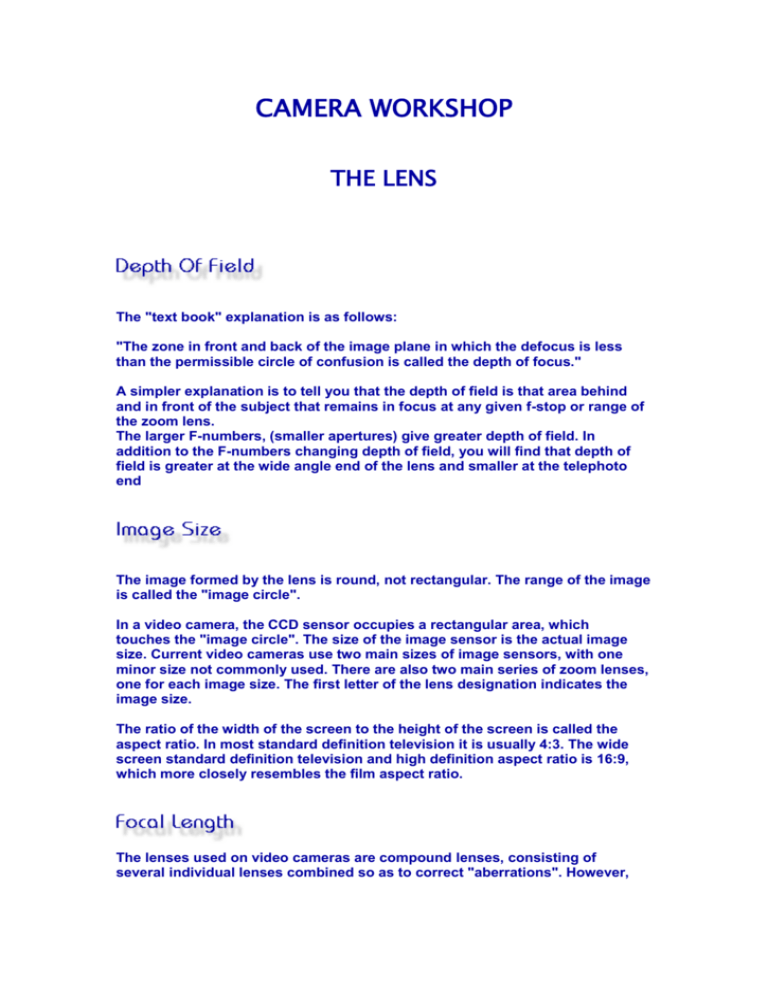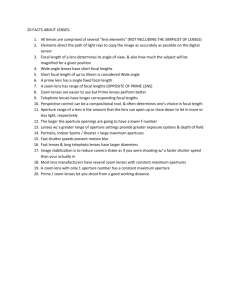CAMERA WORKSHOP 1 THE LENS
advertisement

CAMERA WORKSHOP THE LENS The "text book" explanation is as follows: "The zone in front and back of the image plane in which the defocus is less than the permissible circle of confusion is called the depth of focus." A simpler explanation is to tell you that the depth of field is that area behind and in front of the subject that remains in focus at any given f-stop or range of the zoom lens. The larger F-numbers, (smaller apertures) give greater depth of field. In addition to the F-numbers changing depth of field, you will find that depth of field is greater at the wide angle end of the lens and smaller at the telephoto end The image formed by the lens is round, not rectangular. The range of the image is called the "image circle". In a video camera, the CCD sensor occupies a rectangular area, which touches the "image circle". The size of the image sensor is the actual image size. Current video cameras use two main sizes of image sensors, with one minor size not commonly used. There are also two main series of zoom lenses, one for each image size. The first letter of the lens designation indicates the image size. The ratio of the width of the screen to the height of the screen is called the aspect ratio. In most standard definition television it is usually 4:3. The wide screen standard definition television and high definition aspect ratio is 16:9, which more closely resembles the film aspect ratio. The lenses used on video cameras are compound lenses, consisting of several individual lenses combined so as to correct "aberrations". However, they function like a single lens located at an imaginary point called the "principal point". The focal length is the basic factor used to calculate the image position and magnification of a lens. The focal length of a video lens is important as a parameter describing the angle of view of the lens. The focal length and "principal point" of a zoom lens are changed by zooming, so as you zoom, you change the angle of view of the lens. A short focal length gives a wide angle of view, and a long focal length gives a narrow angle of view, which causes the image to be magnified. The focal length is the basic factor used to calculate the image position and magnification of a lens. The focal length of a video lens is important as a parameter describing the angle of view of the lens. The focal length and "principal point" of a zoom lens are changed by zooming, so as you zoom, you change the angle of view of the lens. A short focal length gives a wide angle of view, and a long focal length gives a narrow angle of view, which causes the image to be magnified. The zoom ratio is the ratio of the focal length at the telephoto end of the zoom to the focal length at the wide-angle end. The zoom ratio indicates how much the size of the image on the monitor can be changed. If a zoom lens has a zoom ratio of lOx, the image it gives at the telephoto end will be magnified exactly 10 times as much as the image at the wide-angle end. You can use the model numbers on the lens to determine its zoom ratio. An A16X8.5 or J16X8.5 is essentially, at the telephoto end, 16 times 8.5 millimetres. The larger the zoom ratio is, the more the size of the image can be changed. It is important to select an appropriate zoom ratio. A large zoom ratio is desirable, but it also makes the lens bigger and heavier. An item of equal importance with the focal length is the F-stop/number, which indicates the brightness of the image formed by a lens. A smaller F-stop means a brighter image. The F-stop is closely related to the depth of field. For a given focal length, the larger the aperture of the lens is, the smaller its F-number is. The iris ring of most lenses are marked with a series of numbers with a ratio of 1:1.4, 1.7, 2, 2.8, 3.5, 4, 5.6, 8, 11, 16, 22. The brightness of the image is inversely proportion to the square of the F-number. Each time the ring is turned one number up the F scale, the brightness is decreased by half. As the iris ring is turned down one number, the brightness is increased by twice. As many people know, movie camera lenses are rated by a T-number instead of an F-stop. The F-stop expresses the speed of the lens on the assumption that lens transmits 1OO% of the incident light. In reality, different lenses have different transmittance, so two lenses with the same F-stop may actually have different speed. The T-number solves this problem by taking both the diaphragm diameter and transmittance into account. Two lenses with the same T number will always give the same brightness.





